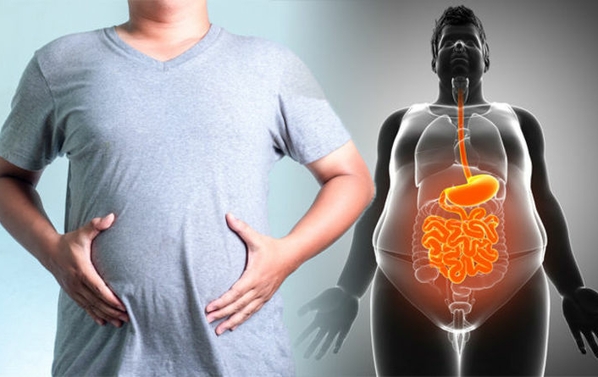Health and Wellness
Why and How to Get Rid of Belly Fat
Visceral fat is belly fat found deep within your abdominal cavity. It is not the fat that you can pinch on your belly, but the fat that wraps around your organs inside your abdomen, including your liver, kidneys, and pancreas. Excess visceral fat is a serious problem.
Some levels of visceral fat are healthy and help protect your organs. However, too much visceral fat can be dangerous for your health. It is linked to obesity, chronic inflammation, insulin resistance, increased risk of heart disease, increased risk of cancer, estrogen dominance, mood imbalances, and increased risk of dementia. Since it’s an underlying root cause of many chronic health issues, it is important that you understand more about it.
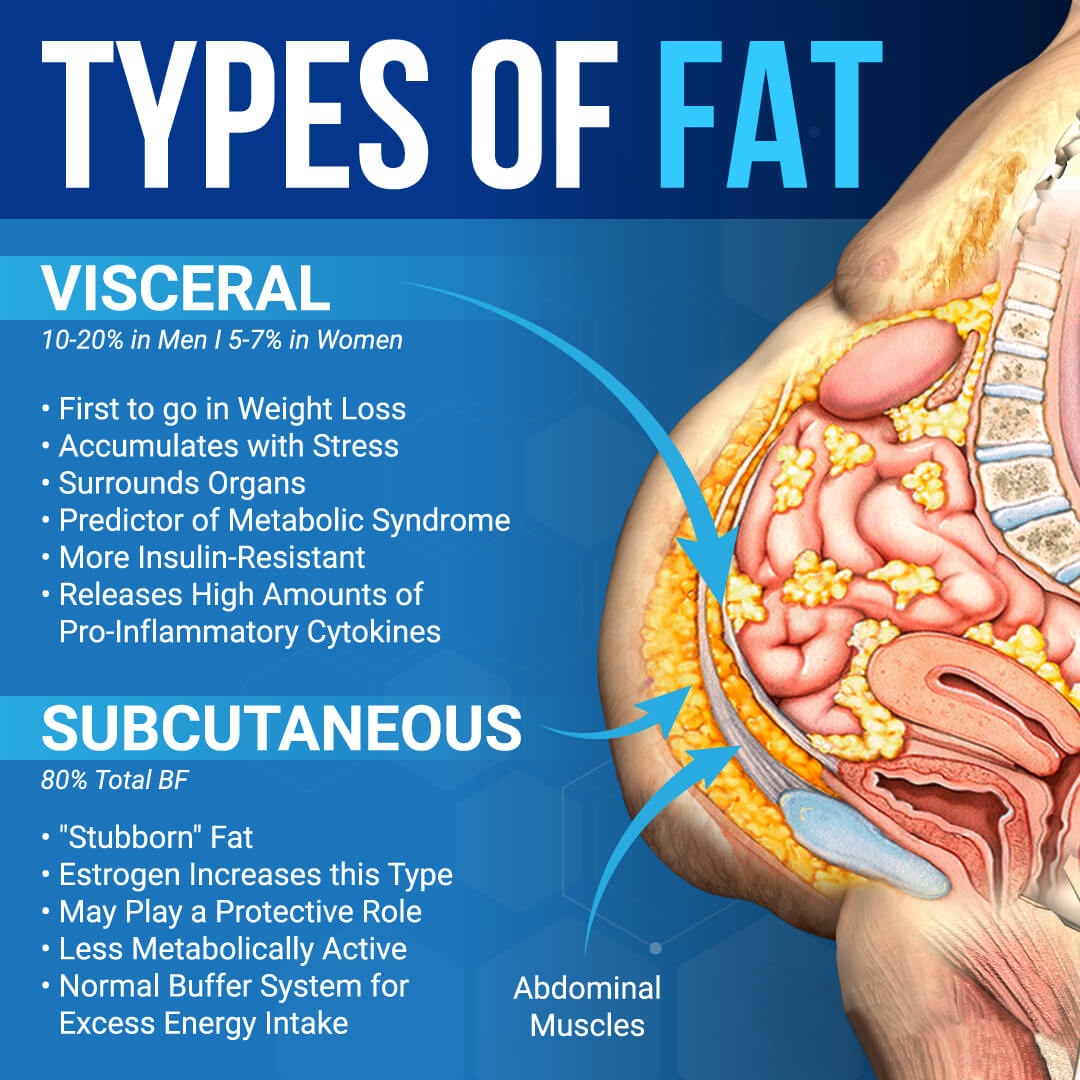
What Is Visceral Fat?
Visceral fat is a type of fat that accumulates in your intra-abdominal adipose tissue. It is not the belly fat you can pinch. Subcutaneous fat is the belly fat that you can see and touch around your middle. Visceral fat, on the other hand, is a gel-like fat that wraps around and in-between your organs inside your abdomen. It may be found around your liver, pancreas, and kidneys.
A large waist and a protruding belly are signs of having too much visceral fat. Visceral fat is a much more serious problem than subcutaneous fat.
Too much visceral fat can interfere with organ function and how your body operates. Visceral fat can trigger your body’s inflammatory pathways and increase inflammation. It can interfere with signaling between molecules and normal hormonal functions. As a result, it may interfere with your hunger levels, weight, brain function, and other areas of your health.
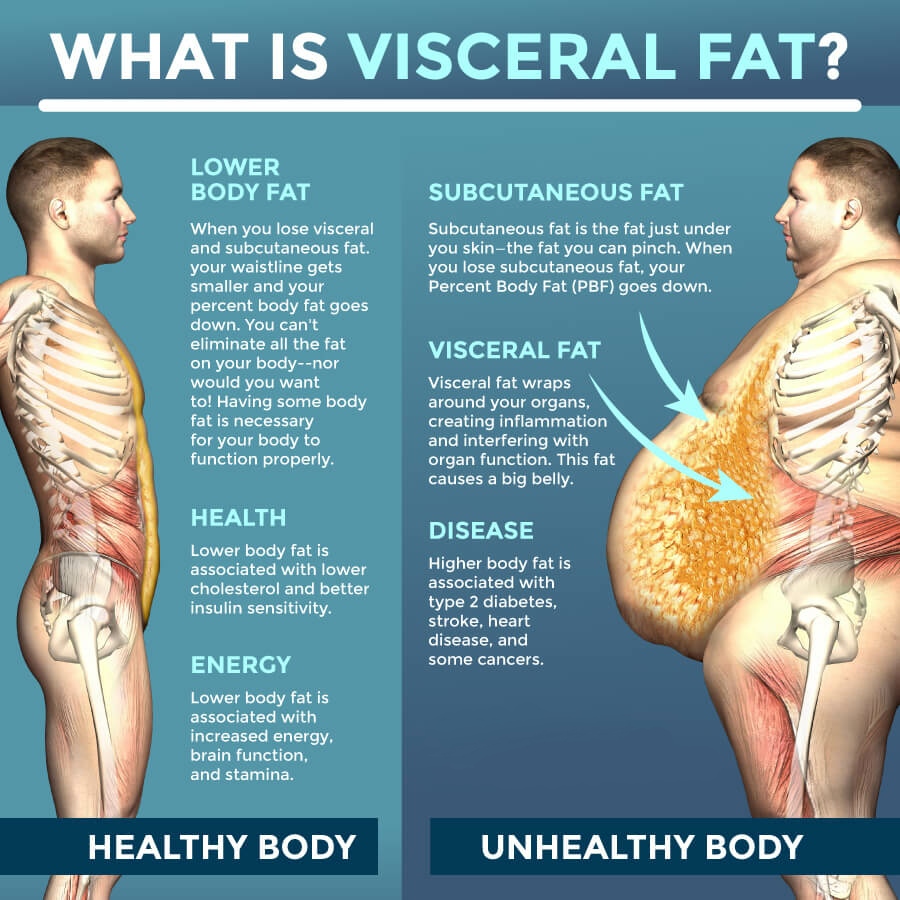
Visceral fat can increase the risk of an array of health issues, including:
- Obesity
- Coronary heart disease
- Stroke
- Diabetes
- Cancer
- Dementia
- Arthritis
- Sleep disorders
- Sexual dysfunction
- Depression
- Hormonal health issues
Long-lasting inflammation may cause plaque to form inside the arteries, which is a risk factor for heart disease.
Plaque is a combination of cholesterol and other substances. It grows larger over time and can eventually rupture.
When this happens, the blood in the arteries clots and either partially or completely blocks blood flow. In the coronary arteries, a clot can deprive the heart of oxygen and cause a heart attack.
The “portal theory” also helps explain why visceral fat is harmful as it suggests that visceral fat releases inflammatory markers and free fatty acids that travel through the portal vein to the liver.
The portal vein carries blood from the intestines, pancreas, and spleen to the liver.
This may cause fat to build up in the liver and potentially lead to liver insulin resistance and type 2 diabetes.
What are the symptoms of visceral fat?
A growing belly is the most obvious sign of visceral fat, but that can indicate subcutaneous fat as well. Some studies show if you have a potbelly — or are more “apple-shaped” than “pear-shaped” — you may have more visceral fat.
What causes visceral fat?
Genetic and environmental factors determine the amount of visceral fat you collect. Genetics determine your body shape and how your body stores visceral fat.
But environmental factors such as diet and exercise play a key role as well. A poor diet with a high intake of fatty foods and carbohydrates (sugars) and an inactive lifestyle provides the building blocks for an increase in visceral fat.
However, stress is a factor too. Stress activates a hormone in your body called cortisol. More cortisol activates your body’s “fight-or-flight” response, which triggers the storage of more visceral fat.
When it comes to a healthy weight, appetite, and mood, your blood glucose (or blood sugar) levels are critical. Your blood glucose levels are controlled by a hormone called insulin. Insulin helps to decrease your blood sugar levels after eating a sugary or high-carbohydrate meal.
When your body is digesting your food, it breaks down sugar and starches into smaller units, glucose, or fructose. Glucose and fructose can then enter your bloodstream. This urges your pancreas to release insulin to help move blood sugar into your cells across your body. Blood sugar is then stored and used for energy to support the brain, muscular, and tissue function.
Insulin doesn’t only take care of your blood glucose, though. It is in communication with your body’s fat store, including your visceral fat. No wonder that some people call insulin the “fat-storage hormone”.
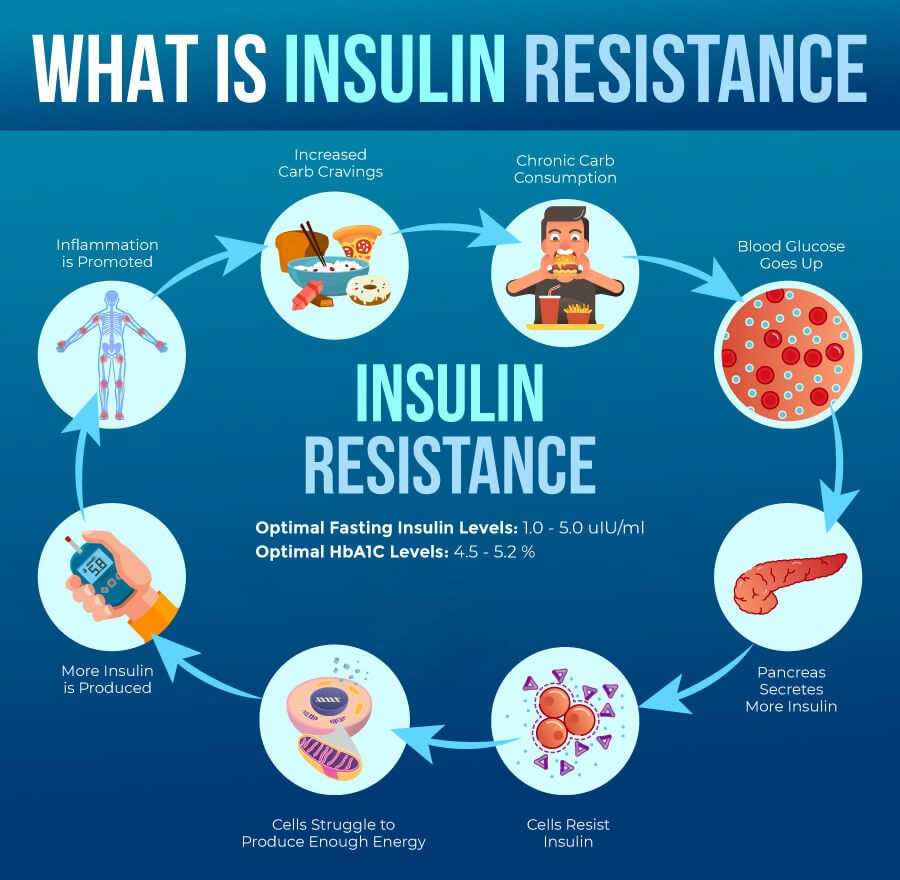
If there is too much blood glucose in your system, your body will store this excess glucose as fat. This usually happens if you are eating too many refined processed carbs and sugary foods, including white bread, white pasta, white rice, cakes, cheese, or candy.
These high-carb/sugar, low-nutrient foods get quickly converted into simple sugars. They enter your bloodstream right away and cause a rapid release of insulin. This can not only lead to excess visceral fat and weight gain, but can also feed the vicious cycle of hunger, overeating, sweet cravings, and the inability to resist carbs.
The problem is that the longer this cycle continues and the longer your blood insulin levels stay high, the more likely you will gain excess visceral fat and the more likely you will battle with ongoing weight problems.
Insulin is also in constant touch with your other hormones, including your stress hormone cortisol made by your adrenal glands. Adrenal health issues, abnormally high cortisol, and other hormonal imbalances can lead to low energy, mood fluctuations, cravings, urges to eat, weight gain, inflammation, and an increased risk of chronic disease.
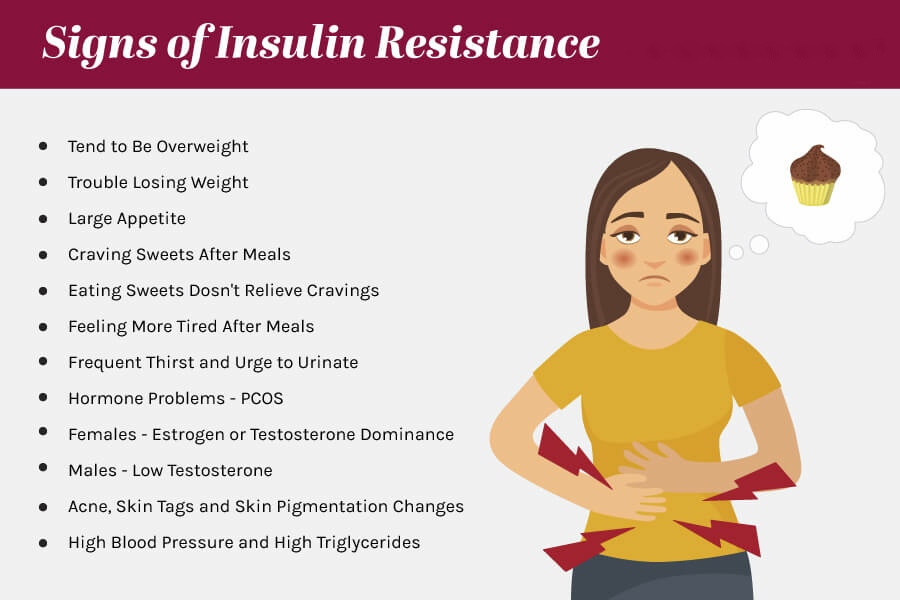
Measuring Visceral Fat Levels
The only way to measure your visceral fat levels exactly is by using an MRI or CT scan. However, these procedures are not only expensive but are also unnecessary. You can take some easy measurements at home or with the help of your doctor that can indicate your risk for visceral fat.
Calculating your waist to hip ratio and waist to height ratio is the best way to figure out your risk factors. It’s simple and completely free. Here is how to do it.
Waist to Hip Ratio
Calculating your waist to hip ratio (WHR) at home is simple. However, if you need help, you can always ask for assistance from your healthcare provider. Here is how to do it:
- Stand up straight. Don’t slouch.
- Find the smallest part of your waist. It is generally located right above your belly button. Measure your waist circumference with a tape measure.
- Find the widest part of your hips or buttocks. Measure your hip circumference here with a tape measure.
- To calculate your waist to hip ratio, divide your waist circumference by your hip circumference.
According to the World Health Organization (WHO) and 2001 study published by the International Journal of Obesity and Related Metabolic Disorders a waist to hip ratio of .85 for women and .90 for men may indicate abdominal obesity and increases the risk of diabetes and other metabolic issues.
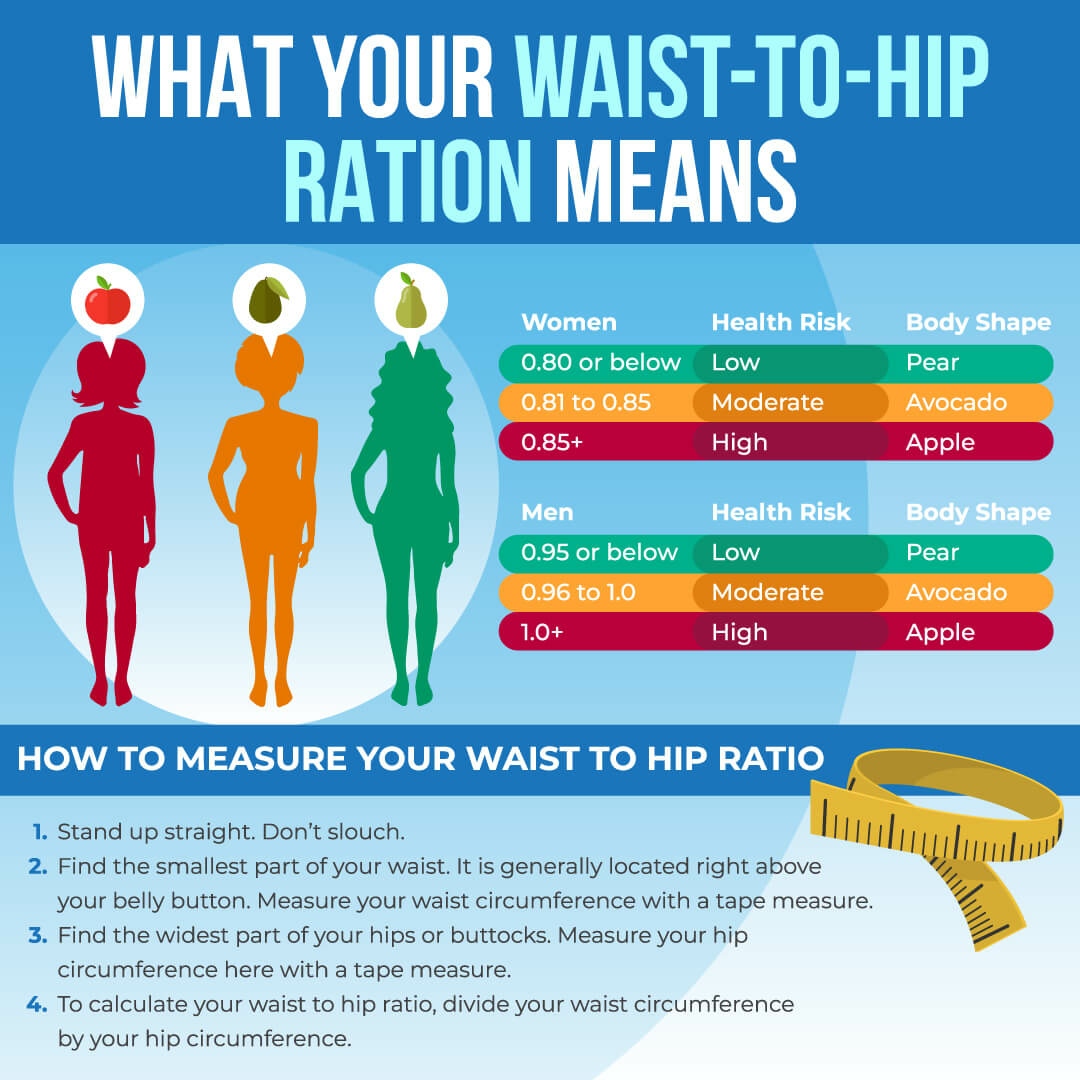
Waist to Height Ratio
You may also look at your waist to height ratio (WHtR). A 2020 study published in Nature has found that this number is a particularly good indicator of visceral fat in people with type 1 diabetes. Researchers linked larger waist circumference to higher visceral fat percentage. They have found that the waist to height ratio is a better indicator of health issues and mortality than body mass index (BMI) and body shape index (ABSI).
To calculate your waist to height ratio at home:
- Measure your waist circumference with a tape measure just like I explained earlier.
- Divide your waist circumference by your height.
- If you measure your height in inches, use inches for measuring your waist. If you are using centimeters for your height, make sure to use metrics for your waist circumference as well. Both work equally as long as you are using the same units for your waist and your height.
A healthy waist to height ratio should be no greater than .50. I recommend that you calculate both numbers to get a more accurate picture.
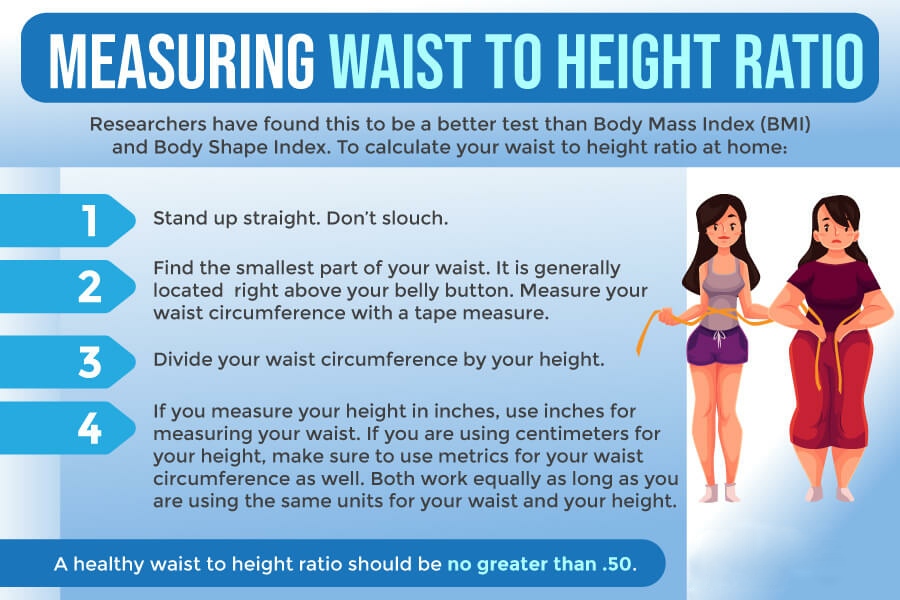
Testing for Inflammation
Measuring your waist to hip and waist to height ratio is not enough. Increased visceral fat holds an array of health risks, including chronic inflammation, insulin resistance, diabetes, cardiovascular issues, and other health problems. I will go over these health risks in the next section.
Checking certain labs for inflammation, blood sugar, and lipids is important to determine your risks, especially if your ratios for visceral fat are high.
I recommend getting a Comprehensive Blood Analysis and a Complete Urine Analysis test done, which are great comprehensive lab tests that allows us to look at all these factors of your health. These are some of the specific tests included:
Blood Sugar
I recommend looking at your blood sugar levels:
- HbA1C: The ideal number is between 4 and 5.6 percent. Between 5.7 and 6.4 means that you have a high risk of developing diabetes, and over 6.4 means that you have diabetes.
- Fasting Glucose: Less than 100 mg/dL (5.6 mmol/L) is normal. 100 to 125 mg/dL (5.6 to 6.9 mmol/L) is considered prediabetes. 126 mg/dL (7 mmol/L) or higher on two separate tests means you have diabetes.
- Fasting Insulin: Normal fasting insulin levels are between 75–95 mg/dL (4.2–5.3 mmol/L). Over 95 mg/dL (5.3 mmol/L) shows insulin resistance and over 110 mg/dL (>6.1 mmol/L) shows severe insulin resistance.
Inflammatory Markers
I recommend looking at your inflammatory markers:
- HsCRP: The ideal number is under 1.
- LDH (lactose dehydrogenase): The optimal range is 140 to 180. High levels indicate chronic inflammation.
- Serum ferritin: The ideal range is under 150. High levels indicate inflammation.
- Homocysteine: The optimal range is 6 to 9.
Lipid Panel
I recommend a lipid panel test looking at the following areas:
- VLDL cholesterol: The ideal range is 5 to 30 mg/dl.
- HDL cholesterol: The idea range is 55 to 80. Levels above 100 can indicate chronic inflammation or active infection in the body.
- Triglycerides: The ideal range is 40 to 80.
Having a balanced ratio of LDL to HDL and triglycerides to HDL is essential for your health. Ideally, we are looking for an LDL: HDL Ratio: 3:1 or less, 2:1 being optimal. For triglycerides, we are looking for an HDL Ratio: 2:1 or less, 1:1 being optimal. Higher triglyceride and lower HDL levels are typically an indication of insulin resistance and high fasting insulin level.
Problems with Excess Visceral Fat
#1 - Increases Systemic Inflammation
One of the biggest problems with excess visceral fat is that it increases systemic inflammation in your body. It creates hormonal and inflammatory molecules. This puts enormous stress on your liver. If you have excess visceral fat around your liver, kidneys, pancreas, heart, and intestines, it creates even further inflammation and disrupts your metabolism feeding a vicious cycle of chronic inflammation and related health issues.
What’s interesting about visceral fat is that besides creating chronic inflammation in your body, it also becomes inflamed itself by creating and releasing an inflammatory molecule called interleukin-6. This can trigger autoimmune reactions and lead to a list of chronic diseases.
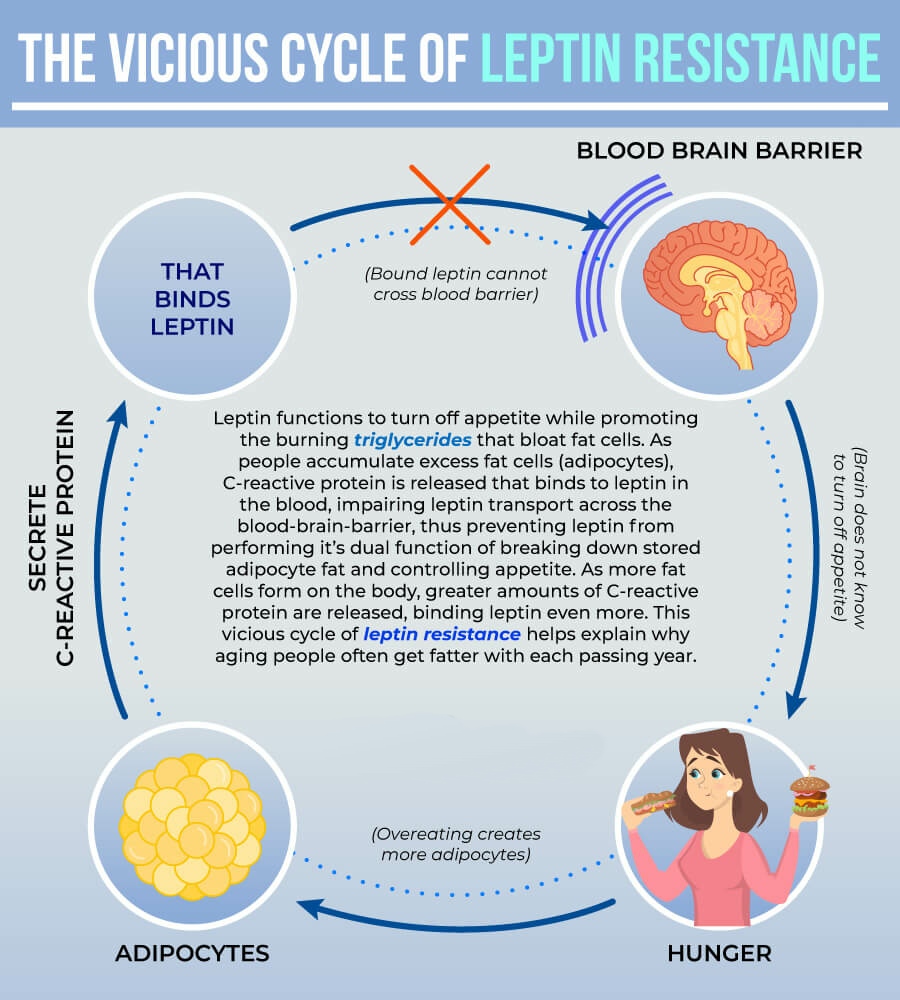
#2 - Leads to Insulin Resistance, Diabetes, and Carb Cravings
You already learned that visceral fat plays a role in the development of insulin resistance. Insulin resistance increases your risk of prediabetes and diabetes; however, you can have insulin resistance without prediabetes or diabetes as well.
While being overweight or obese itself can increase your risk of various health issues, abdominal fat, and visceral fat more specifically, puts you at a higher risk of diabetes and other chronic diseases than hip or thigh fat. Improving adipose tissue function and reducing visceral fat can play an important role in reducing insulin resistance.
Whether you have diabetes or not, visceral fat can contribute to insulin resistance.
Unfortunately, having excess visceral fat can further feed the cycle of obesity and the risk of insulin resistance or diabetes by increasing your cravings. While eating too many calories, and too many foods high in sugar and refined carbohydrates can increase your visceral fat in your body, visceral fat itself can increase your cravings for sugar and carbs.
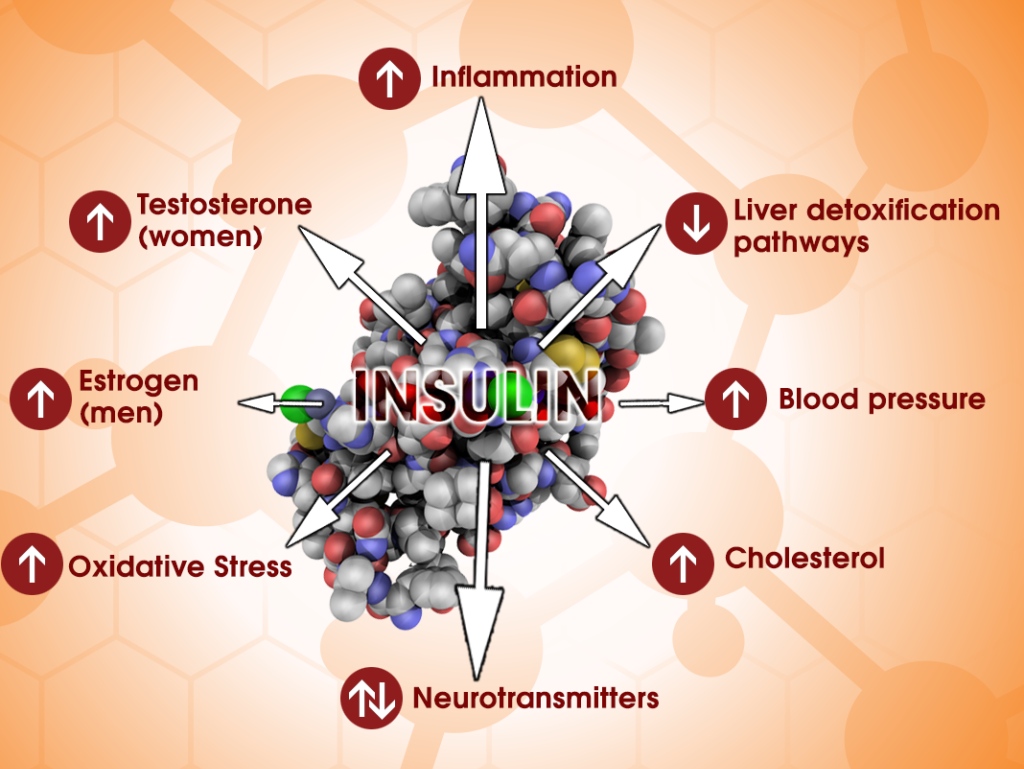
#3 - Higher Risk of Heart Disease
Excess visceral fat also increases your risk of heart disease. As you know, visceral fat increases chronic inflammation and inflammatory cytokines in your body. These fat-generated inflammatory cytokines are some of the top root causes of heart disease and other inflammatory conditions.
Visceral fat can lead to high triglycerides or hypertriglyceridemia. It can also increase pro-inflammatory cytokine production, inflammation, and liver insulin resistance.
It may increase bad cholesterol levels and negatively affect metabolic functions.
It may also lead to high blood pressure and the formation of plaque buildup in your arteries. All these are important cardiovascular disease markers that show an increased risk of cardiovascular disease.
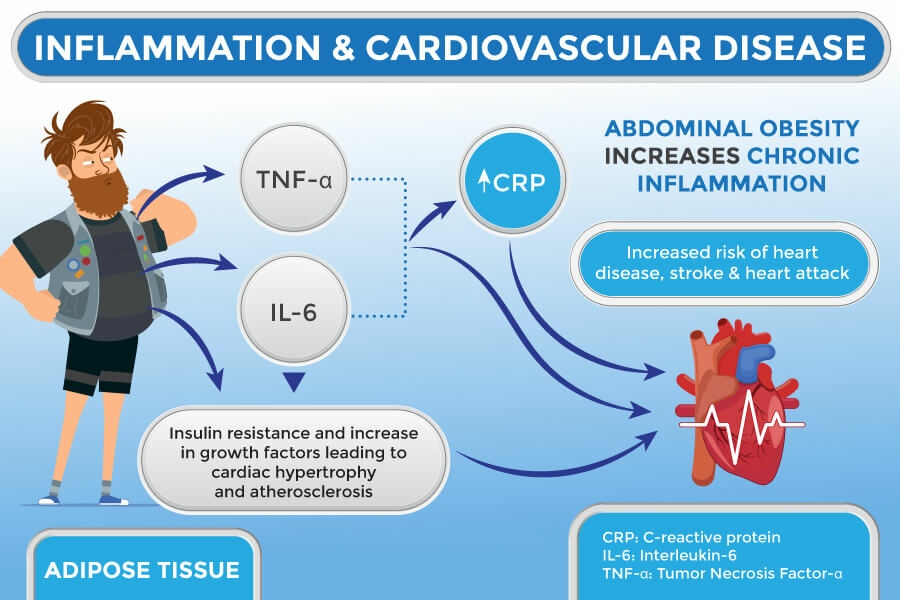
#4 - Estrogen Dominance
Estrogen and progesterone are the two primary female sex hormones that, beyond reproduction and childbearing in women, are also responsible for your metabolism, thyroid health, hormonal health, cholesterol levels, brain health, mood, bone health, and skin health. In a healthy body, estrogen, and progesterone work together in a nice balance. However, when your body starts making too much estrogen and/or your progesterone levels drop too low, your estrogen and progesterone levels get out of balance, and you develop estrogen dominance.
Estrogen dominance is a common problem that can lead to premenstrual symptoms (PMS), endometriosis, infertility, hot flashes, menstrual cramps, decreased libido, fibrocystic breasts, uterine fibroids, ovarian cysts, weight gain, fatigue, headaches, depression, mood imbalances, brain fog, thyroid issues, and cancer. Estrogen dominance may affect men as well and lead to fatigue, insomnia, brain fog, weight gain, irritability, mood swings, depression, anxiety, and low libido.
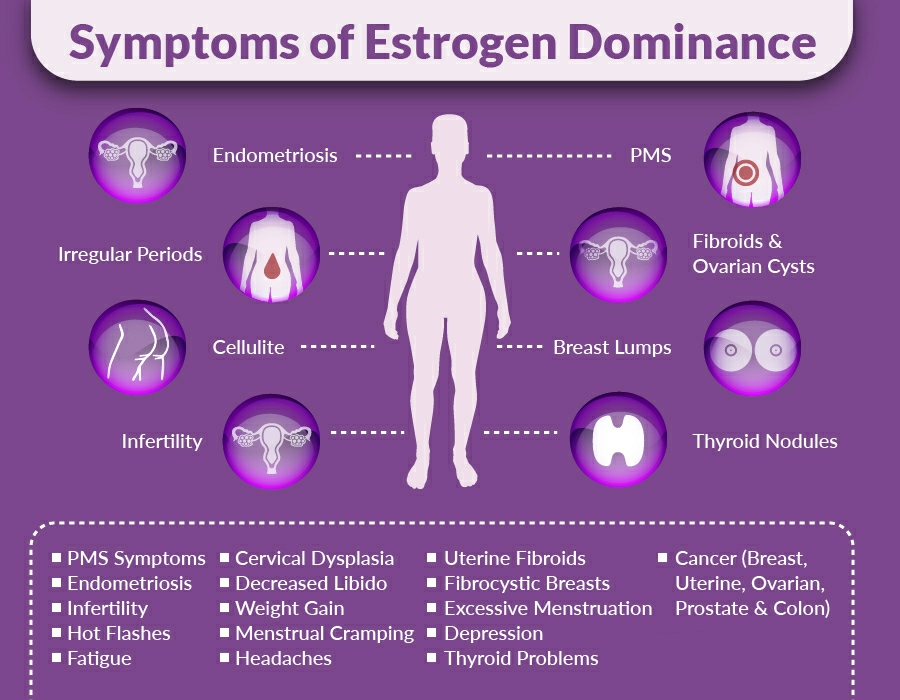
Visceral fat is one of the major risk factors for estrogen dominance and estrogen dominance can further feed the problem of visceral belly fat.
Androgens are male sex hormones that can be found in and affect both males and females. Aromatase is an enzyme in your body that converts androgens to estrogens. The problem is that visceral fat increases aromatase in your body that can lead to estrogen dominance and a long list of serious health issues.
Too much visceral fat and an increase in adipose tissue leads to an increase in aromatase. Since aromatase converts testosterone to one of the estrogen hormones, estradiol, it leads to a decrease in testosterone levels. This favors the development of visceral fat and increases your total body fat index. It may also cause hormone resistance for insulin and leptin.
Too much leptin prevents your body from fighting weight gain but feeds the problem of visceral obesity and insulin resistance instead.
Insulin resistance causes elevated triglyceride and bad cholesterol levels that can increase your risk for heart disease. The combination of these issues can increase your risk of hormonal imbalance, obesity, hypertension, heart disease, type 2 diabetes, extreme fatigue, sleep problems, and depression.
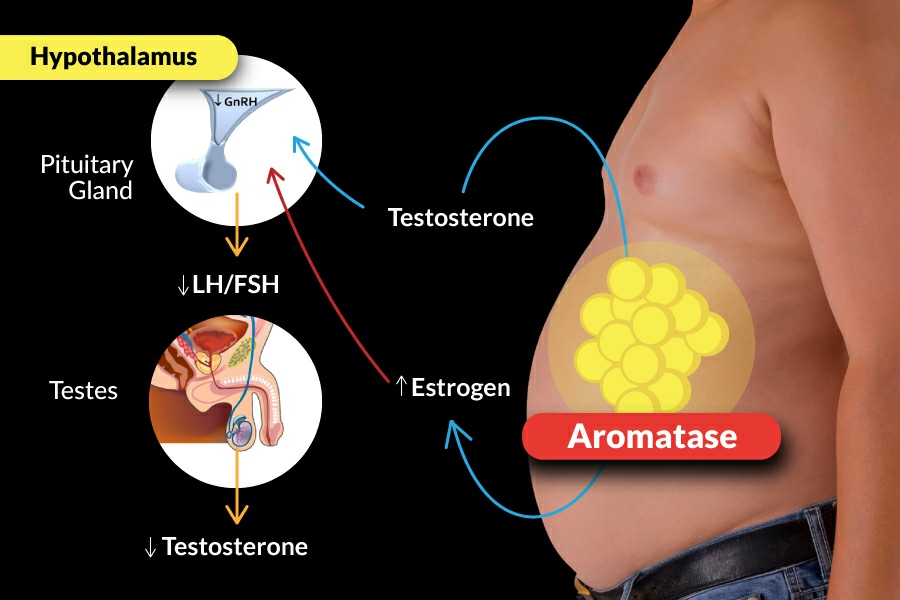
#5 - Cancer Risk
Cancer may develop for three main reasons. One reason may be an increase in estrogen. This may be increasingly problematic for women after menopause. After menopause, estrogen made by the fat cells of women starts to multiply faster in the breasts and the womb, increasing the risk of cancer. Another root cause of the development of obesity-related cancer is insulin and growth factors.
Excess fat can cause levels of insulin and other growth factors to rise, which can lead the cells to divide more rapidly.
The third important root cause of cancer is chronic inflammation. Cells in your fat are called macrophages that release inflammatory cytokines that encourage cell division, including cancer cell division, that can increase your risk of cancer. Unfortunately, excess visceral fat can increase estrogen dominance, increase insulin and growth factors, and increase chronic inflammation. The combination of these three issues can become a breeding ground for cancer.
High levels of body fat, abdominal visceral fat, and obesity may increase your risk of all forms of cancer, especially hormone-based cancers, such as ovarian, breast, and prostate cancer. Being obese and having high levels of visceral fat can also worsen your prognosis and survival rate.
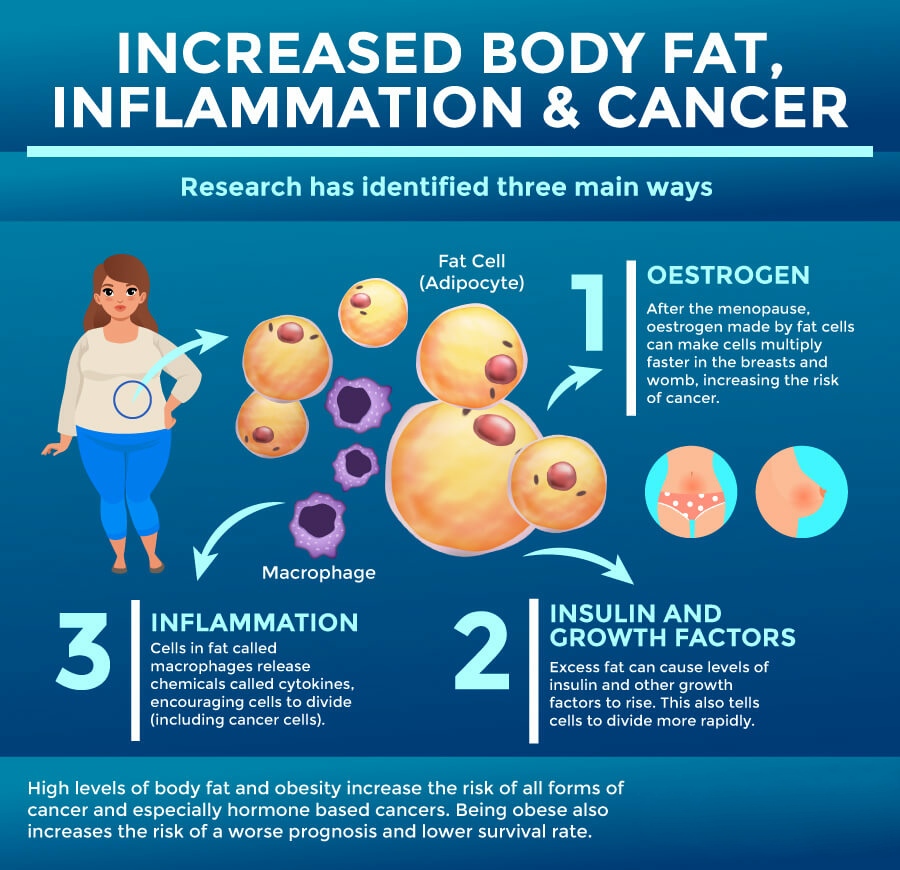
Visceral fat and obesity increase inflammatory cytokines, TNF-alpha and IL-6, in your body and lead to increased levels of CRP which indicates increased chronic inflammation in your body. Obesity and visceral fat also increase insulin resistance and growth factors. The combination of this can increase cellular division, DNA damage, and the risk of cancer.
Breast cancer and ovarian cancer are cancers that affect women. But men are also not free from the risk of obesity-related cancer. Increased visceral fat and obesity increases the risk and prognosis of prostate cancer.
Moreover, visceral fat and obesity can increase the risk of other types of cancers that may affect both men and women. Visceral fat increases the risk of intestinal and pancreatic cancer.
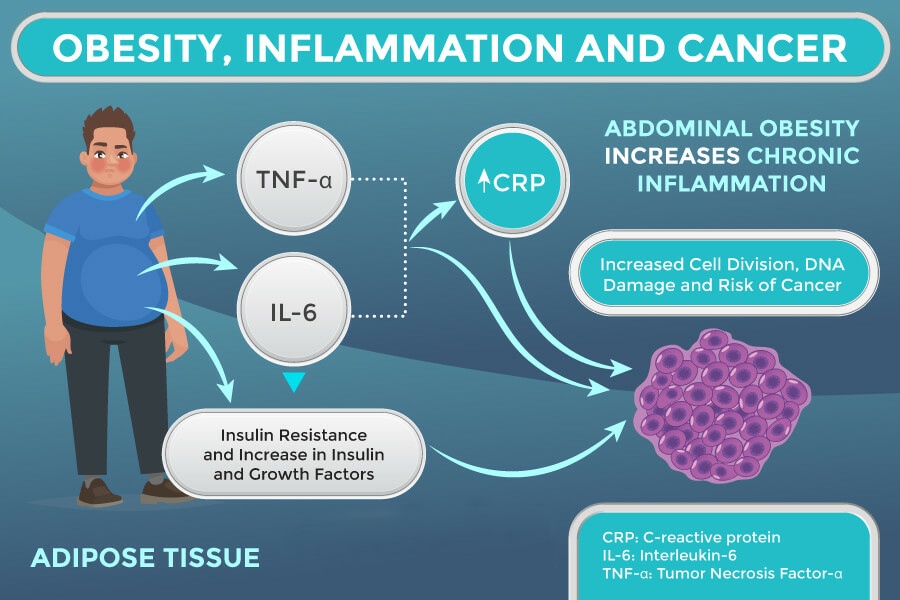
#6 - Mood Disorders
Excess visceral fat can also increase your risk of mood disorders, including depression and anxiety. Your mood is greatly affected by your diet. A poor diet and overeating increase the risk of obesity which can negatively affect your mood.
A low mood and stress can increase overeating and cravings for carbs, sugary and unhealthy foods that may feed this cycle.
An increase in visceral fat can impact your brain and impair insulin and leptin signaling. It may be surprising, but leptin and insulin play a role in your emotions and mood and an imbalance can increase depression and anxiety. Visceral fat and obesity increase your risk of metabolic issues, poor metabolic signaling, and chronic inflammation which also negatively affect your mental health and increase the risk of anxiety and depression.
Increased visceral adipose tissue is linked to the increased risk of depression.
This likely happens because visceral fat is a metabolically active fat that interferes with neurotransmitter function. Since depression may cause greater fat storage in women, it’s particularly important for women to follow a healthy diet that reduces visceral fat and depressive symptoms.
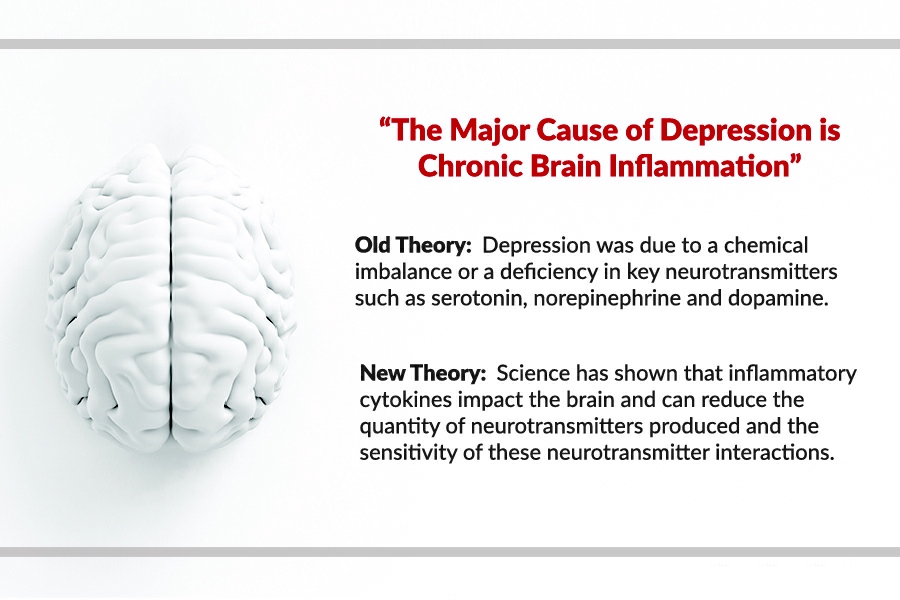
#7 - Increased Risk of Dementia
Excess visceral fat and obesity can also increase your risk of Alzheimer’s disease and dementia.
People with higher visceral fat have a higher likelihood of developing dementia.
People with an apple shape tend to have a higher waist to hip ratio and have a higher likelihood of dementia than people with a pear shape and low waist to hip ratio. Obese people with the highest abdominal measures and highest BMI have a 360% higher chance of developing dementia than those with the lowest abdominal measures and a healthy BMI.
Increased visceral fat and visceral adipose tissue (consisting of adipocyte cells) presents a higher risk factor for dementia compared to high BMI. BMI measurements are commonly used to predict risk factors for health issues; however, it may not be the best indicator.
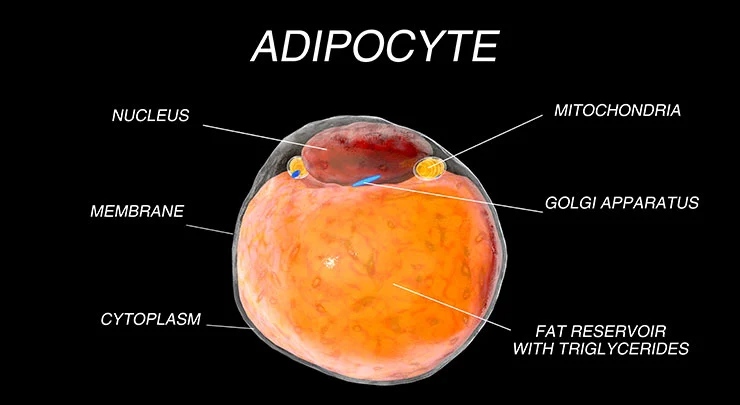
Prior research suggests that a high BMI can certainly indicate an increased risk for dementia, however, the latest research shows, looking at visceral abdominal fat may be an even better indicator. Increased visceral adipose tissue and visceral fat can cause chronic inflammation, hormonal imbalance, and neurochemical imbalances which can lead to a decline in cognitive functions. Excess visceral fat also leads to increased cardiovascular risk factors, including insulin resistance, inflammation, high blood pressure, and atherosclerosis, that may also contribute to a decline in cognitive functions.
Even the bodies of individuals who have a healthy weight or are even underweight may successfully mask excess visceral fat with a normal or low BMI.
As a result, they may also have an increased risk for dementia and other health problems without knowing about it. Looking at visceral fat and waist to hip ratio instead of only BMI is important to look at one’s risk factors for dementia or other chronic or progressive health issues.
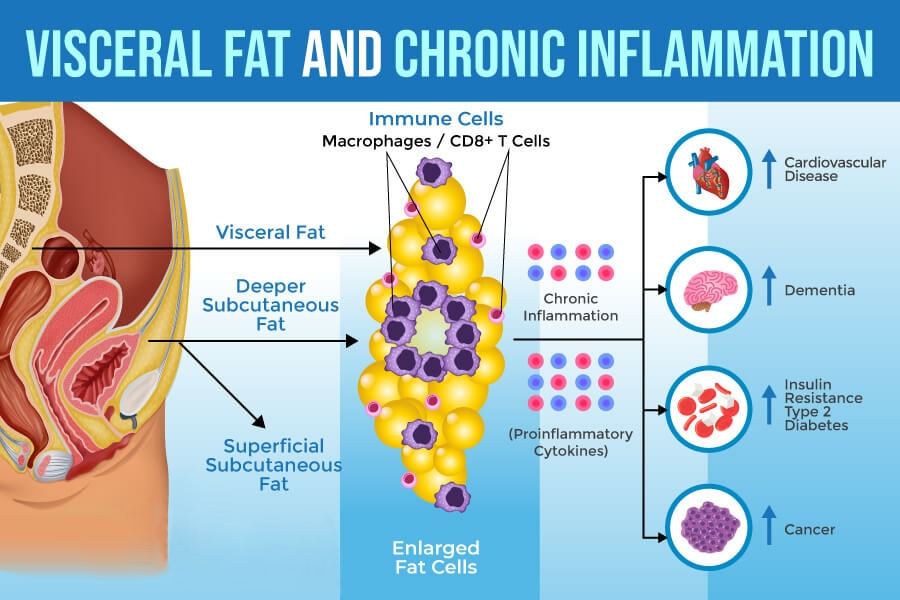
Management and Treatment
How do you get rid of visceral fat?
The best way to lose visceral fat is by maintaining a healthy lifestyle. You can lower your visceral fat level by focusing on the same diet and exercise plans you would do to help you lose weight and lower your total body fat. Ways to reduce visceral fat include:
- Exercise: You should try to exercise for at least 30 minutes a day. This can include cardio or strength training. A popular workout is high-intensity interval training (HIIT). HIIT workouts cycle between bursts of intense effort and quick recovery. HIIT offers resistance and aerobic training, which can help you burn fat faster. Regular aerobic exercise is a great way to shed visceral fat.
If you want to get started with aerobic exercise, start with brisk walking, jogging, or running at least two to three times per week.
- Eat a healthy diet: A healthy diet includes lean proteins, whole grains, fruits, and vegetables. Try to limit trans fats, dairy, refined sugars, sodium, and processed foods. Low-carb diets such as the ketogenic (keto) diet can help reduce visceral fat by training your body to burn fat as fuel rather than carbs. After an initial period of ketogenic (keto) diet (several weeks) switch to mediterranean diet and preferably your blood-type based diet for the long-term.
- Eat More Soluble Fiber: Fiber can be divided into two broad categories — soluble and insoluble. The soluble kind mixes with water to form a viscous gel-like substance. This helps slow down the delivery of digested food from the stomach to the intestines. When soluble fiber reaches the colon, it’s fermented by gut bacteria into short-chain fatty acids. These fatty acids are a major source of nutrition for colon cells. Interestingly, they may also help reduce visceral fat by suppressing your appetite.
To increase your fiber intake, try eating more flaxseeds, sweet potatoes, legumes, and grains. You can also try taking a soluble fiber supplement.
- Try a Probiotic: Probiotics are live bacteria that can benefit your gut and digestive health. They are found in supplements and foods like yogurt, kefir, sauerkraut and natto. They may reduce dietary fat absorption in the gut, increasing how much of it you excrete in feces. In addition, probiotics may help promote higher levels of GLP-1, a fullness hormone, and ANGPTL4, a protein that may help reduce fat storage. I recommend checking out the Enviromedica® Terraflora Deep Immune, or, your blood-type specific Polyflora – Pre/Probiotic
- Intermittent fasting: Intermittent fasting is a weight loss strategy that involves going through periods of eating and not eating. It may help reduce your levels of visceral fat. Skipping a meal occasionally is fine or for a day here and there but avoid long periods of fasting as that has its own health implications. Stay hydrated!
- Good sleep hygiene: Get a good night’s sleep. Not getting enough sleep may increase your risk of additional visceral fat. You should try to get at least six to seven hours of sleep a night.
- Reduce your stress: Stress activates a hormone in your body called cortisol. More cortisol activates your body’s “fight-or-flight” response, which triggers the storage of more visceral fat. Try yoga or meditation to lower your stress level. I recommend checking out the Healthy Minds Program App.
- Limit your alcohol intake: Drinking too much alcohol may increase the amount of visceral fat your body stores.
Common Questions
How much visceral fat is normal?
The normal visceral fat range should be about 10% of your body fat. You can figure out your visceral fat level by calculating your total body fat percentage and then taking off 10%. If your body fat percentage is higher than recommended, then your visceral fat range will be too.
Is visceral fat hard to lose?
Visceral fat is actually easier to lose than subcutaneous fat. This is because it metabolizes quicker, and your body can get rid of it as sweat or pee. If you start regularly exercising and eating a healthy diet, you should start to see results in a few months.
What foods cause visceral fat?
You should try to limit trans fats, refined sugars, carbs, sodium, and processed foods. Trans fats are artificial fats that can increase your storage of visceral fat. Baked goods, processed foods, some dairy and fried foods contain trans fats. You should also limit soda, candy and other foods sweetened with partially hydrogenated oils or high-fructose corn syrup.
Final Thoughts
Visceral fat is a fat that accumulates in your abdomen. Excess visceral fat is a serious health risk. It can increase your risk of obesity, chronic inflammation, insulin resistance, diabetes, heart disease, cancer, estrogen dominance, mood imbalances, and dementia. Since visceral fat is an underlying root cause of many chronic health issues, I recommend that you bookmark this article as a future reference and share it with your friends and family.
Body-Field Scan
Ready to find out what's impacting your energy levels by using our bioenergetic scanning technology. Check out your body’s energy with a Body-Field scan and gain deeper insight into your holographic self with our certified Bioenergetic Practitioner. For an In-Clinic visit click here, or, for a Telehealth (remote) session click here.
We offer a completely new, alternative and bioenergetic health care approach based on 21st century science, technology and quantum physics with personalized, holistic therapy solutions such as, NES body-field scan & therapy, miHealth biofeedback, PEMF, Scalar Wave, Rife and Vibroacoustic (VAT) healing modalities that can restore optimal health and well-being throughout the body, mind and spirit in the most natural way. Let us help you restore your health and energy!



